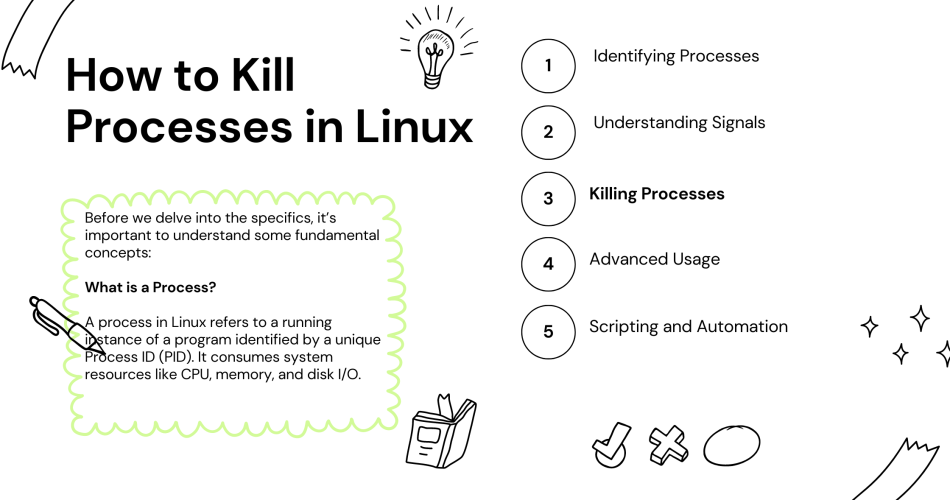Killing processes in Linux is essential for any system administrator or power user. It allows you to terminate unresponsive programs, free up system resources, and maintain stability. This guide will provide a deep dive into the various methods, commands, and best practices for process management in Linux, enriched with real-world examples, advanced tools, and key considerations for server management.
Introduction
Before we delve into the specifics, it’s important to understand some fundamental concepts:
What is a Process?
A process in Linux refers to a running instance of a program identified by a unique Process ID (PID). It consumes system resources like CPU, memory, and disk I/O.
Why Kill Processes?
Killing processes enable you to regain control over unresponsive programs, troubleshoot issues, conserve resources, and prevent instability caused by runaway processes. While graceful termination is preferred, forceful killing is sometimes necessary.
Prerequisites
To effectively utilize the techniques discussed here, you’ll need:
- Access to a Linux system with root or sudo privileges.
- Basic knowledge of the Linux terminal.
Identifying Processes
Identifying the process you want to kill is the first step. Here are some methods:
ps – Lists currently running processes.
ps aux
pgrep – Find processes by name.
pgrep firefox
pidof – Get PID of a process by name.
pidof bash
top – Interactive process viewer and monitor. Also, consider htop for a more advanced, user-friendly interface. 
When analyzing processes, focus on the PID, COMMAND, %CPU, %MEM columns.
Understanding Signals
Linux signals are a method for interrupting processes and triggering actions. Key signals include:
- SIGTERM (-15) – Termination request allows graceful shutdown.
- SIGKILL (-9) – Forceful immediate termination.
- SIGSTOP – Pauses a process.
- SIGHUP (-1) – Hangup signal used for reloads/restarts.
- SIGINT – Interrupt from the keyboard.
Refer to man 7 signal for a full list of signals.
“Signals provide a useful way to communicate with processes and manage their execution.”
Killing Processes
Terminating processes can be achieved through several approaches:
kill – Send a signal to a process by PID.
kill 1234 kill -9 1234
killall – Terminate by process name. It is useful for killing multiple instances.
killall process_name killall -9 process_name killall -o 1h process_name # Kills processes older than 1 hour
pkill – Combines pgrep and kill for flexible pattern matching.
pkill process_pattern pkill -9 -t tty1 process_name
xkill – A graphical tool to kill a process associated with a window.
Advanced Usage
Leverage signals for more advanced process management:
- Use
killall -oandkillall -yto kill processes based on age. - Terminate processes by the user with
killall -u username. - Interactive termination and monitoring with
topandhtop.
“With experience, you will know which technique works best for each scenario.”
Scripting and Automation
Automating process management tasks using shell scripts can be a game-changer. Here’s an example script that checks for and kills high CPU usage processes:
#!/bin/bash # Script to kill high CPU usage processes MAX_CPU_USAGE=80 # Set your CPU usage threshold here high_cpu_processes=$(ps aux | awk -v max_cpu=$MAX_CPU_USAGE '$3 > max_cpu { print $2 }') for pid in $high_cpu_processes; do kill -15 $pid echo "Killed process $pid exceeding CPU usage limit." done
Use cron jobs for regular process monitoring and maintenance.
SystemD and Service Management
Modern Linux distributions predominantly use SystemD. Manage services with systemctl for starting, stopping, and restarting services. Understand when to use traditional process management commands vs systemctl.
Cautions and Best Practices
- Exercise caution when killing critical system processes.
- Prefer SIGTERM and only use SIGKILL if necessary.
- Review
kill -lfor signal options. - Monitor for unintended side effects to maintain system stability.
Additional Tools and Commands
Explore more utilities:
- Browser-based terminals like Hostinger VPS for remote management.
pgrepfor filtering processes.- Man pages (
man kill,man ps) for detailed information.
Troubleshooting and Security Considerations
If killing a process does not go as planned, assess the risk involved and possible dependencies. Be aware of security implications, especially when handling processes related to security features.
Conclusion
Mastering process management is crucial for effective Linux administration. This guide has covered essential commands like kill, pkill, killall, their appropriate use cases, and best practices to ensure efficient and stable system management.
